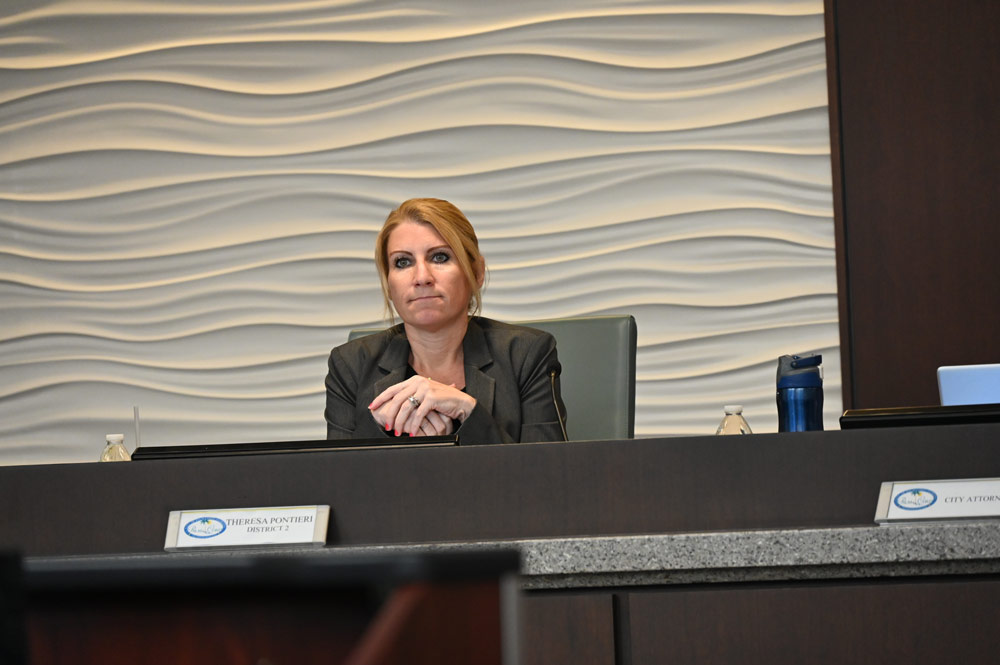
Defying the threat of a lawsuit by a developer, the Palm Coast City Council late Tuesday evening voted 5-0 to stand by its decision last year to limit the Cascades development in Seminole Woods to 416 single-family houses.
The council had in 2023 approved a limit of 850 dwellings, then reversed course in the face of staunch opposition. The additional housing units would have been apartments–always a volatile subject in Palm Coast, where prejudices against apartment complexes persist despite a shortage. But a city infrastructure under strain also factored into opposition to the higher density. The council’s defiance reflects how far the pendulum has shifted against development.
Last November, Byrndog LLC, the Douglas Properties subsidiary behind the development, sent a so-0called claim letter to the city under the Bert-Harris Act. The developer made a claim for $12.2 million, the revenue it calculated the city was denying it by denying the higher density. The claim letter is a required first step under law in what would then likely turn into a lawsuit, if the city were to refuse the claim, or refuse to negotiate a settlement. The city had until today to respond.
City Attorney Marcus Duffy brought up the matter at the end of Tuesday’s meeting, referring to the Nov. 6 claim letter. He recommended two options: either “stay put” with the previous decision, or offer more density (a higher number of entitled housing units). He said 219 single-family houses “could be offered.” But not apartments. The 5-0 vote was to stay put.
The council rallied behind Council member Theresa Pontieri, who approved of a 416-unit development but had led the opposition to 850 units since Byrndog requested the increase in 2023. Pontieri is the only member of the council who was on the council in 2023 and 2024, when it voted on the Byrndog requests in a series of meetings. Numerous residents in support of standing by the 416-house limit addressed the council Tuesday.
“We cannot continue to annex in property and then double density,” Pontieri said. “We have water problems in this city. The applicant stood at that podium right there and accused me of fear mongering. He called me a fear-mongerer, and said, You are fear mongering, talking about the issues with water. Here we are. Two years later. We are under the thumb of DEP because of our water issues.” The city is under a consent decree from the Department of Environmental Protection because one of its two sewer plants is often over capacity. “I am also concerned with the infrastructure for our roads and our traffic. Again, I’m called a fear monger.”
The council’s defiance reflects how far the pendulum has shifted against development.
Pontieri, an attorney, all but invited a lawsuit as she summarized the history of the case in the language of a legal pugilist. “We’re not dealing with facts that support this claim,” she said. “We’re not dealing with law that supports this claim. We’re dealing with somebody who is trying to bastardize our system. And I cannot abide by that. When I look at the letter, the Burt-Harris letter that was sent to our attorney, it is so hollow and truly lacks any merit whatsoever.” She called the letter “legally insufficient” (a term usually used by judges who toss out lawsuits), then took explicitly took on the attorney who wrote the letter.
Council member Ty Miller said he’d been “torn” about how to respond to the claim letter, but Pontieri’s summary analysis convinced him to side with her. “I’m open to persuasion in these cases, and I think you did a very good job of that,” Miller told Pontieri. “My biggest concern is risk and trying to reduce that. A price tag of multi millions dollars is a lot for us to bear.” Council member Charles Gambaro said the risk is substantial. Some municipalities have defeated such claims. But he asked: what if Palm Coast lost? How will it pay?
Duffy didn’t directly answer the question. He told Gambaro the city would have to pay the claim, plus attorney fees, which Gambaro already knew. He did not say how the city would pay. Gambaro said if the council was willing to assume that risk, he’d go along. But he wanted the risk to be clear. The council assumed the risk. (Pontieri made the motion, Council member Ray Stevens seconded.)
“I was on the council during this entire process, and it is my opinion, very strong opinion, that this is yet a third bite at an apple from a developer to try to get more density that they’ve never been entitled to, that they have no right to,” Pontieri said. She summarized the history of the matter, which dates back to when the land was under the county’s jurisdiction. In 2005, the Cascades was a planned unit development, or PUD, approved by the county for 416 single-family houses. The city annexed the property. “We granted that annexation based on the fact that it was 416 single family units,” Pontieri said.
“Now I asked during that meeting, what’s on the back end of this? What are you guys going to ask from us?” Pontieri said. “Because inevitably, these developers often do come back and ask for more, and lo and behold, that’s exactly what happened.”
Pontieri is not remembering quite correctly. She had not actually verbalized her concern about what would come next. She had only thought about it. There’d been no such discussions or controversies at the time the land was annexed. The council passed the annexation ordinance on Aug. 1, 2023. There was no discussion of dwelling units. The brief discussion focused only on the fact that the annexation stemmed from the developer’s request for city utility services, which made annexation automatic. Pontieri asked only if the city had any discretion in the matter. A planning staffer said the city had no such discretion. here was more discussion about the location of the land in relation to the county airport than about dwelling units, which were not discussed. The motion passed unanimously.
The matter returned to the council in September 2023 as a comprehensive plan amendment and rezoning, when Senior Planner Jose Papa said there would be an increase in the approved housing units. “The limit of 850 dwelling units is an increase over the 416 dwelling units which was permitted within the approved PUD,” he said. “850 is a cap,” he said.
It was at that meeting that Pontieri raised objections and sought to keep the total number of housing units at 416. Jeff Douglas, the developer, just as strongly objected to the characterization of the rezoning as “doubling” housing units on the PUD, since the additional units were tied not to the original land, but to a so-called “hook piece” (so described because the parcel is in the shape of a hook) that was added to the overall plan. In the developer’s view, that addition provided for the right to add dwelling units. Byrndog intended to build apartments there. But even to city planners (and their documentation), the proposal added up to a doubling of units.
“I’m not okay with this. I understand that property owners have rights. I understand that things change. I understand that we’re growing as a city, and I am in favor of all of those things,” Pontieri said at the September 2023 meeting. “But when we’re looking at the concentration of the density, that’s smoke and mirrors because we’re talking about a four-story building that we’re putting up against homes.” She also referred to the city’s utility capacity. “I was fine with annexing this property in. I remember when we annexed it in, because it wasn’t that long ago, thinking to myself, I wonder what the ask is going to be on the tail end of this. And here we are.” (Emphasis added.)
In Byrndog’s view, it had agreed to be voluntarily annexed into the city “In reasonable reliance on the assurances and representations of the City that no limit lower than 850 dwelling units would be imposed,” Steven Gieseler, the attorney representing the developer, wrote in the Nov. 6 letter. But annexation wasn’t contingent on density, but on the developer’s utility needs. While density may have been an administrative assurance, it was not binding absent council approval. The council did approve the 850 housing units in the first reading of the rezoning ordinance, then reversed in the face of public opposition.
That pre-annexation agreement may be a key part of litigation, if it comes to that. “If we do go to trial with these people,” Mayor Mike Norris said, “I will love to see the testimony of the people they said negotiated that deal pre annexation. I’ll happily open up that court for them to come and testify.”
Joy Cook, who described herself as “the voice of Seminole Woods for the past two years,” urged the council “not to give into the demands of this and settle with this developer,” and that the council’s decision “should remain just that: final. This threat of a lawsuit opens up doors for a new loophole for all developer-builders to use as a negotiation tool. If they don’t get what they want, they will sue in hopes that the city will settle and get them closer to their original goal.”
“You guys did nothing wrong,” another Seminole Woods resident said. “You fought for what was right for the city and your residents. You made a very good business decision. This decision should stand. Please do not let these developers or builders or attorneys strong arm you in revisiting your good and binding decision. Stand your ground and say no for the last time.”
The council had taken up the matter past 8:30 p.m. Tuesday. It was not on the agenda, but as was reported here Monday, every council member and numerous residents knew it would be brought up. The developer or his representatives were not in the room.
![]()




























Jan says
Good for the Council. 416 houses are enough for the Cascades development.
Frank says
Everything in palm coast is bulldozed and destroyed. Glad i moved last year from this town. Developers ruined a nice peaceful town. Now its just like the rest, orlando, Jacksonville, Daytona.
Kandi Stevens says
Prove we have the water to supply to ALL the new home. PROVE we have the utility capacity as well. WE DO NOT! New council. New precedent. Excellent job!!!
Land of no turn signals says says
Theresa Pontieri leading the fight against these developers.I hope this is just a start for more ridiculous projects in Flagler.
Doug says
If Palm Coast really wanted to earn some respect, they would put a moratorium on all development. Developers need to know that they don’t control growth, the people who voted those commissioners into office do. Stop the overdevelopment and madness.
celia pugliese says
Thank you Councilwoman Pontieri for spearheading the NO and also to Councilman Stevens for second her motion. You have the backing of us all Palmcoasters! Is worth to attend these meetings to lobby for our safety, health, peace, quiet and the preservation of the value of our homes! TY Palm Coast Council and Mayor. We will win! No judge will approve their frivolous demands.
celia pugliese says
Pontieri been fighting against these additional 416 units since 2023 when she said….:“My issue is the fact that we have 14,000 dwelling units in the pipeline right now just this year that we’ve approved, and this is adding to it,” Pontieri had said as the council was preparing to approve a rezoning for the 850-home Cascades development in Seminole Woods (on first reading). https://flaglerlive.com/category/copscourts/florida-supreme-court-copscourts/
Endless dark money says
Laws apparently are just whatever conmen make up. Elon and the felon are deciding how our money is spent without congress. So much for laws. Who’s overseeing Elon and what he does in all the tech systems? Nobody lol. Enjoy billionaires telling you to suffer and pay more cause they are inhumane racists.
Just saying says
If you look at the trends and data, many of these mega developments are going to go bust before they are completed. I hope they don’t leave a lot of unsightly half developed lots. There are many unbiased informative Florida real estate videos that only give you real data.
DennisC Rathsam says
FRANK…. Where did you move too I want out too!
Shark says
Get ready to lose another lawsuit Pontieri !!!
Protonbeam says
We shall see. Property owners have rights, even developers. I think the story is way more complex than Miss Ponteri is letting onto and I’m not sure she’s telling the truth or the whole truth . Palm Coast was a master plan community with this much density preplanned 30 years ago. At the council meeting, I attended last night people who got up and ranted and raved about it and other issues act like their house just sprung from the ether surrounded by moon beams, unicorns and sunshine, and that they’ve caused no impact themselves to the community. Shame on the city for ignoring water and sewer infrastructure for the last three years. Also, the city is failing to appropriately manage its facilities, and that tab is going to be huge when it comes due!
Lastly when I was at the meeting I was surprised to see the perennial gadfly, liar, and community dirtbag Dennis McDonald at the mic – got to have some degree of mental illness. Did he ever pay all of his debts to the county for all the lies he tells and got spanked for?
Constituent says
Thank you Theresa!!!!!!
celia pugliese says
Protonbeam real dirtbag is one that hides behind and alias and insults us residents, like outstanding community leader Dennis McDonald for warning and telling us like it is and what is done wrong against our best interest as PC residents. What a coward you are trying to mud those that fight for our quality of life, from the shadows of an alias…What are you afraid of to disclose who you are?
its me and I don't care says
I suspect you are linked to developers, certain real estate persons or perhaps the planning board as we know there are/were some suspect people on it. So with elections coming up are you now trying to put poor planning with water increases and infrastructure issues on the boards she served? NAH, BS! You know this started with Holland and Alfin giving away to higher density. We know you will have a plan to attack her for re-election. After hearing David Ayres, a Chamber sycophant use these same tactics this morning at her on the radio to say she’s responsible for not approving rate increases for water- its apparent this will be the method of attack. Y’all are assholes! Plain and simple – assholes!
its me and I don't care says
This was meant for Protonbeam